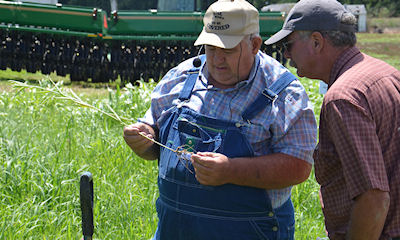
Soil experts from all over the country and some homegrown right here in Indiana descended on the Hoosier state over the last few months. They attended numerous field days and even the 2015 Farm Progress Show, spreading the word about soil health.
Here's part of the message they conveyed through these events.
Deep roots: Radishes put on deep roots with good diameter, says Barry Fisher of the Natural Resources Conservation Service. This radish root tapers off because the soil at the Farm Progress Show plot was compacted. It made it through the compacted soil, but tapered the diameter to do it.

Ag experts talked to lots of farmers about ways to improve soils this year, including cover crops.
Fuzzy is good! Barry Fisher points out mycorrhiza growing along the base of this cover crop plant that extends into the soil. They are very helpful in adding to soil health, he says. Not all cover crop plants produce them to this extent.
~~~PAGE_BREAK_HERE~~~
Note variety and size: Awide variety of cover crop plants were seeded in this demonstration mix. Note that where plants are thinner, each plant is bigger with more growth.
Quick growth: Barry Fisher shows how big leaves are on this plant. This plot had only ben seeded about five weeks. In fact some who seeded cover crops early where crops were destroyed by flooding were concerned they were too big, and considered burning them off this fall. Daniel Perkins of the Iroquois Watershed strongly advised against it.
~~~PAGE_BREAK_HERE~~~
Root search: Ray Weil from the University of Maryland spent three weeks in Indiana both teaching and learning about soil health. He studied how far roots went in this soil pit on Clint Arnholt's farm. Arnholt has seeded cover crops in this field for many years.
Soil changer: Ray Weil says cover corps over the past half dozen years and no-till for some 20 years are helping change this soil. He used different colors of golf tees to map out root patterns form cove4r crop roots from the past and from corn roots. He noted that a plow layer as still evident, even after years of no-till and cover crops.
~~~PAGE_BREAK_HERE~~~
Examine each crop: Ohio farmer Dave Brandt came from his farm in the center of the state to Roger Wenning's farm at Greensburg to show other farmers which cover crops he likes best and why. He often plants mixes of around a dozen cover crops.
Try other covers: Farmers like Roger Wenning who have been in cover crops for a while try other types of crops that might add something to the mix. Some are better at nitrogen scavenging, others at producing N, and still others at rooting deep into the soil. Sun hemp was one of the cover crops Wenning demonstrated during his field day this year.
~~~PAGE_BREAK_HERE~~~
Twist on older mix: Dairy farmers and beef producers who wanted quick growth have used various types of sudangrass for years. It's offers quick growth, but can get tall if planted too early. This plot on Roger Wenning';s farm also included cow peas.
Soil crumbles! Note the loose structure of this soil from one of Wenni9ng's cover crop plots. He has grown cover crops of various types on this plot for years. This particular plant helps loosen the soil.
~~~PAGE_BREAK_HERE~~~
Buckwheat as a cover crop: This mix on roger Wenning's farm included buckwheat as a cover crop. Wenning experiments on his own, and also put out some mixes that Brandt uses for others to see. Wenning more typically uses three to five cover cops when seeding entire fields.
Root check: Barry Fisher shows roots of buckwheat plants to farmers visiting Roger Wenning's field day to learn about cover crops. Most left knowing that you need to pick cover crop types depending upon what you are trying to accomplish for soil health.
About the Author(s)
You May Also Like




